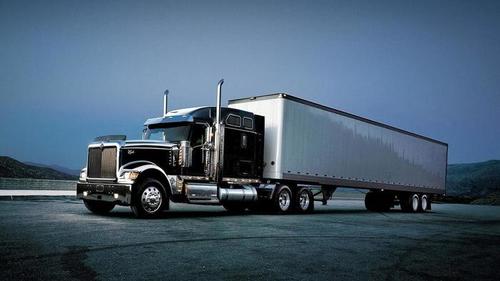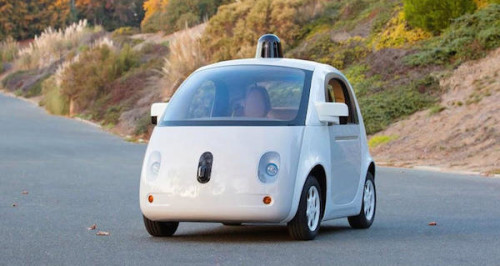
Automation: Self-driving 18-Wheeler Trucks Forecast for Highways in Ten Years
06/30/2015
utIt’s interesting to see that many tech prognosticators see self-driving vehicles to be a reality in a decade (or less). A little Google search experiment got 1.4 million hits for self-driving cars OR trucks decade. The search gets a bunch of junk but also turns up titles like Self-driving cars could be on Britain’s road within a decade — but Government ‘must be ready’.
Google’s tiny urban cars (pictured below) are already cruising the streets of Mountain View. And as Consumer Reports pointed out, some of the components of autonomous vehicles already exist on production cars, such as crash-avoidance systems. Think in terms of cruise control evolving in advanced technological ways — that’s how the changes seem to be moving.
Driving is a major jobs category that employs millions of Americans, from highway truckers to cabbies and delivery drivers. So the autonomous technology for vehicles will be a big unemployer. The ride-sharing business Uber plans on moving into self-driving cars as soon as possible to bypass human drivers who expect payment.
Now the corporate robotizers have targeted highway truckers for obsolescence, even though they are a part of American culture, with films and music.
In 1978, Sam Peckinpah directed the film Convoy, starring Kris Kristofferson, during the craze of CB radios used by long-haul truckers.
The late Johnny Cash appreciated working people and sang a tribute to big-rig drivers in this clip:
But now the suits say they need robot trucks because the industry is “facing a major driver shortage” — but if that were true, wages would be going up to attract more workers. Nope, self-driving trucks are just cheaper, that’s all.
But when half of the jobs in America are done by smart machines in 20 years (as forecast by Oxford University researchers in 2013), who will buy the automation-produced goods and services? How is the brave new economy supposed to function when tens of millions of workers and their paychecks have been made obsolete?
In addition, America won’t need to import millions of immigrants to build houses or drive taxis or pick produce. Millions more excess non-workers will add to the existing suffering in communities hard hit by the globalist economy of outsourcing and mass immigration.
Note that the following report predicts a likelihood of self-driving big-rig trucks functioning in a decade.
Trucks flirt with driverless features, Detroit News, June 29, 2015Within a decade, 18-wheelers may be hauling freight across the U.S. highways without a driver touching the steering wheel or the brakes. And that prospect stands to significantly alter a $700 billion industry and affect millions of professional drivers nationwide.
Just as automakers and tech companies like Google race to develop driverless cars, corporations are ramping up efforts to take humans out of the cabs of semi-trucks.
Daimler test-drove an autonomous heavy-duty truck on I-15 in Las Vegas last month. Auburn Hills-based auto supplier Continental has developed cameras that can replace exterior mirrors on commercial vehicles, including semis, an early step toward developing a self-driving system.
And at an industry conference in September in Detroit, California-based Peloton Technology demonstrated its platooning technology, which lets a lead driver control the acceleration and braking of another truck that follows, saving gas and reducing the likelihood of accidents.
All could lead to fewer humans behind the wheel in an industry that’s facing a major driver shortage.
“I think we’re evolving in that direction,” said Walter Heinritzi, executive director of the Lansing-based Michigan Trucking Association, which represents trucking companies throughout the state.
“Like most industries, we’re relying on fewer and fewer employees. If you can make money without a driver, you’re miles ahead financially.”
The American Trucking Association says 3.4 million truckers moved almost 10 billion tons of freight in 2014. The industry employs more than 7 million, but the number of drivers has fallen in recent years.
The ATA estimates the driver shortage is between 35,000 and 40,000 drivers. Driver turnover at large truck lines was 95 percent in 2014, and 90 percent for smaller carriers, according to the ATA.
“One of the biggest challenges is finding an adequate driving pool,” Heinritzi said. “In essence, you could argue something like platooning would decrease the demand on human truck drivers, and that could work to the industry’s benefit.”
Peloton’s platooning technology connects two trucks via the cloud, and uses safety systems such as active braking, already found on many passenger cars today. The technology acts much like cruise control: Although the lead driver is in charge of braking and accelerating both rigs, drivers are still behind the wheel and control steering and other vehicle functions.
“Whatever the front truck does, the rear truck does at almost the same time,” said Josh Switkes, CEO of Peloton. “It can react much faster than a human could.”
That means fewer accidents, and up to a 10 percent fuel savings for the rear truck because of “drafting.” “The idea of the system is to get a safety and fuel economy improvement,” Switkes said. “It’s proving to be really attractive to fleets.”
‘It’s not replacing them’
Peloton has logged about 14,000 test miles and is using platooning in fleet trials. It’s available for two trucks at a time, but Switkes hopes to boost that to a platoon of three or more.
Platooning is legal in Michigan, according to the Michigan Department of Transportation, although fleets wishing to use the technology would need to get a permit from MDOT to get a variation in following distance from what is legal in the Michigan Vehicle Code.
Switkes doesn’t believe platooning will mean the loss of driver jobs: “We make it very clear that platooning is helping the drivers do their job better; it’s not replacing them. We’ve gotten a pretty positive response from drivers.”
He said he thinks big rigs that can drive themselves with a person still in the cab will be on U.S. roads within 10 years.
Jack Nerad, market analyst at automotive research firm Kelley Blue Book, said it’s likely drivers would still be needed inside the cab of an autonomous truck to supervise and intervene in emergencies. “It might make drivers more productive,” he said.
Safety concerns
Nerad added self-driving trucks are likely coming because of their “obvious cost savings” and greater efficiency.
The biggest issue surrounding the adoption of autonomous big rigs, as with driverless cars, is safety.
In 2013, 3,964 people were killed in crashes involving large trucks in the United States, according to the National Highway Traffic Safety Administration; 71 percent were in other vehicles, 17 percent were truck occupants and 11 percent were pedestrians and others.
Truck drivers have the seventh-highest rate of fatal injuries on the job, behind such groups as loggers, commercial fishermen, miners and roofers, according to the Bureau of Labor Statistics.
While self-driving technology could reduce accidents due to driver fatigue and other lapses, no system is foolproof.
When Daimler demonstrated its autonomous truck in Las Vegas, CEO Martin Daum said the public would likely never forgive a fatal crash blamed on a self-driving semi.
“Consumers might have a great deal of trepidation of a giant driverless vehicle next to them,” Nerad said. “That’s something that has to be surmounted.”

